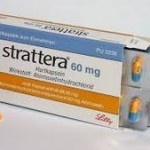Atomoxetine was FDA approved for ADHD in 2002 and touted as a true alternative to stimulants. While it remains popular today, many clinicians report less than stellar results in treating the core symptoms of ADHD. This recent review and meta-analysis by Schwartz and Correll examines all randomized controlled studies of atomoxetine versus placebo. While meta-analyses of this medication have been performed in the past, the authors point out that all were industry sponsored. This one is not, although one of the authors has received financial support from a number of pharmaceutical companies, including the maker of atomoxetine,  Eli Lily.
Eli Lily.
The authors reviewed and applied meta-analytic summaries of all double-blind randomized controlled trials of atomoxetine for the treatment of ADHD in children. In total, 25 studies were found that met inclusion criteria up until August 2012, which included a total of nearly 4,000 patients. The average trial was almost 9 weeks in length, and all but two were industry funded. The average atomoxetine dose was 1.17 mg/kg and the average age was around 10.
In terms of results, atomoxetine was found to be superior to placebo overall in treating core ADHD symptoms of all types. A total of 44.1% with atomoxetine versus 21.4% on placebo achieved improved scores on ADHD rating scales of at least 40%, resulting in a number needed to treat of 4. At the same time, however, nearly 40% of patients did not respond to the medication. In other domains such as oppositional defiant symptoms and overall quality of life, improvement with atomoxetine was unimpressive. Adverse effects including aggression and suicidal ideation did not differ from placebo while other types of side effects were generally mild but higher with atomoxetine.
The authors concluded that atomoxetine appears to be a safe (at least in the short term) and efficacious treatment for pediatric ADHD, relative to placebo, although a sizable number of patients will continue to have significant residual symptoms. The data indicate the possibility of a bimodal response to atomoxetine with many patients responding well and many others have minimal to no improvement. Overall, atomoxetine appears to be about 1/3 to 1/5 less effective than stimulants, with little to guide us in predicting who those patients will be that either respond well or not at all to the medication.
Do these numbers correspond to your own clinical impression? For me, I don’t think I have found atomoxetine to be as helpful as this article would suggest, although it is important to note that these studies used atomoxetine as a first-line agent while in general practice many of us are turning to atomoxetine only after stimulants have failed.
Reference
Schwartz S & Correll C. Efficacy and safety of atomoxetine in children and adolescents with attention-deficit/hyperactivity disorder: results from a comprehensive meta-analysis and metaregression. J. Am. Acad. Child Adolesc. Psychiatry, 2014;53(2):174–187
Tags: adhd, atomoxetine, strattera

